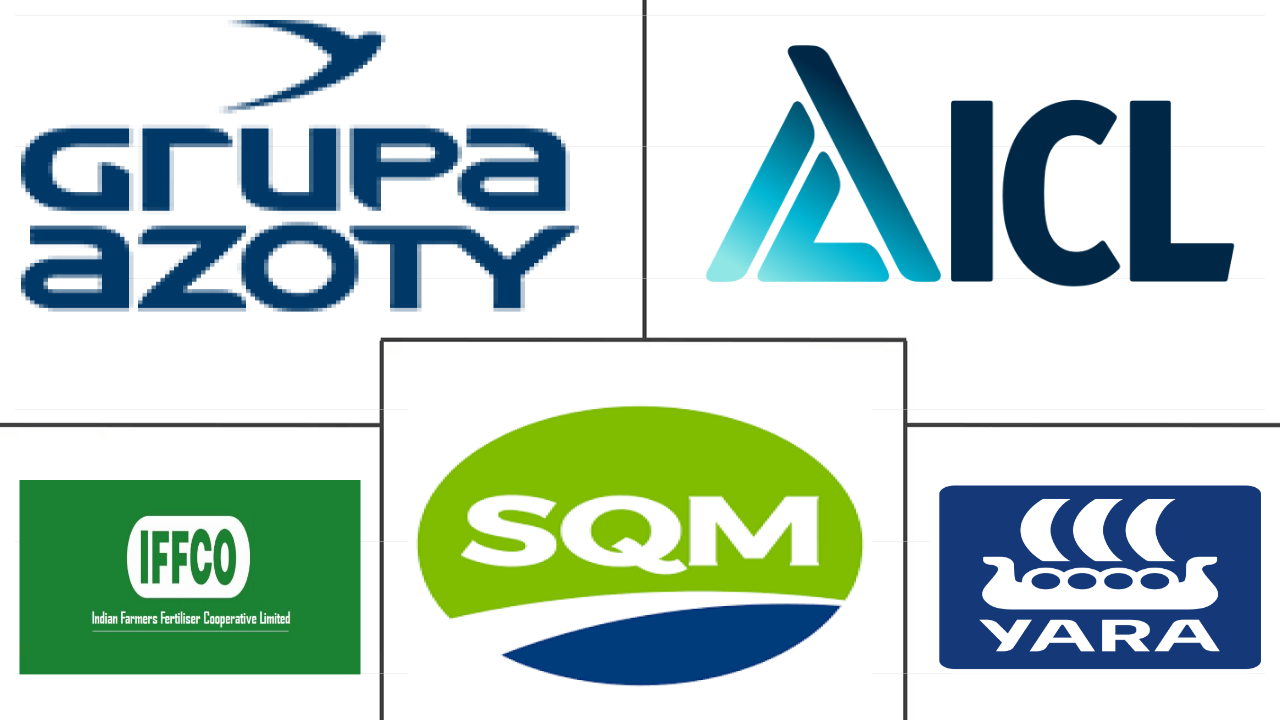Market Size of liquid fertilizer Industry
|
|
Study Period | 2017 - 2030 |
|
|
Market Size (2024) | USD 22.3 Billion |
|
|
Market Size (2030) | USD 31.53 Billion |
|
|
Largest Share by Crop Type | Field Crops |
|
|
CAGR (2024 - 2030) | 5.94 % |
|
|
Largest Share by Region | Asia-Pacific |
Major Players |
||

|
||
|
*Disclaimer: Major Players sorted in no particular order |
Liquid Fertilizer Market Analysis
The Liquid Fertilizer Market size is estimated at 22.3 billion USD in 2024, and is expected to reach 31.53 billion USD by 2030, growing at a CAGR of 5.94% during the forecast period (2024-2030).
22.3 Billion
Market Size in 2024 (USD)
31.53 Billion
Market Size in 2030 (USD)
6.39 %
CAGR (2017-2023)
5.94 %
CAGR (2024-2030)
Largest segment by Type
34.38 %
value share, Nitrogenous, 2023
Nitrogen is a crucial nutrient for plant growth and enhance yield, liquid nitrogen fertilizers are widely used across the regions for their rapid availability to plants.
Largest segment by Application Mode
50.45 %
value share, Foliar, 2023
The foliar feeding method plays an important role when the soil condition is inappropriate, with a lack of ideal pH, imbalances in soil nutrition, and waterlogging conditions.
Largest Segment by Crop Type
7.05 %
Projected CAGR, Horticultural Crops, 2024-2030
The demand for liquid fertilizers is expected to grow significantly due to the trend of increased adoption owing to the precision and efficiency of liquid fertilizers.
Largest segment by Country
35.47 %
value share, China, 2023
China is aiming to reduce fertilizer consumption by using fertilizers efficiently while reducing the fertilizer impact on the environment, thus contributing to market growth
Leading Market Player
10.44 %
market share, Yara International ASA, 2022

Yara International has expanded its liquid fertilizers portfolio and production facilities to meet the growing demand which has contributed to securing a significant share
Field crop consumption of liquid fertilizers is increasing
- Field crops dominated the global liquid fertilizer market, accounting for about 77.4% of the total liquid fertilizer consumption. Their volume consumption of liquid fertilizers was 20.6 million metric tons, worth USD 20.6 billion in 2022. The large consumption of liquid fertilizers by field crops is due to the large area under cultivation of these crops. More than 85.0% of the global agricultural land is dedicated to the cultivation of field crops.
- Horticultural crops are the second-largest crop type that consumes liquid fertilizers, accounting for about 19.2% of the global liquid fertilizer consumption in 2022.
- With increasing concerns for health and nutrition after the COVID-19 pandemic, the demand for high-value crops like fruits and vegetables is increasing worldwide. Vegetable crops with major demand, such as tomatoes, potatoes, onions, cabbage, and cauliflower, consume high amounts of fertilizer and are grown throughout the year. Foliar liquid fertilizers play an important role in fruit crops, as foliar spraying is known to improve the quality of fruits.
- Turf and ornamental crops accounted for a share of about 3.4% of the total global liquid fertilizer market and were valued at USD 863.9 million in 2022, with a volume consumption of 907.2 thousand metric tons.
- The area under cultivation of turf and ornamental crops is increasing with concerns over pollution, the growing importance of aesthetic landscaping in gardens, and ecotourism worldwide. Therefore, the global consumption of liquid fertilizers in respective crop types is anticipated to register a CAGR of 5.1% between 2023 and 2030.
The United States occupied the higher market share in liquid fertilizers consumption in the region
- In 2022, the Asia-Pacific liquid fertilizers market accounted for approximately 49.9% of the global liquid fertilizers market's total value share. Growers in the region are increasingly aware of the advantages of liquid fertilizers, such as their ability to penetrate the soil easily and enable plants to absorb nutrients more quickly. Additionally, liquid fertilizers help reduce fertilizer wastage and can be applied either to the ground or to the leaves.
- Liquid fertilizer represented 21.8% of the North American specialty market in 2022. The United States was the top consumer of liquid fertilizers in North America, with a share of 74.4% in 2022. The liquid fertilizer market in the country was valued at USD 3.1 billion in 2022, with a volume consumption of 3.3 million metric tons.
- Europe is the third-largest market for liquid fertilizers in the world, accounting for about 15.6% of the total liquid fertilizer market. This is due to the dominance of better irrigation systems in the region. For instance, countries like Germany, Russia, the United Kingdom, and France have more than 55% of their irrigated land covered by sprinklers or micro-irrigation systems, thus driving the market in the region.
- Governments across the region are continuously promoting the adoption of micro-irrigation systems through price subsidies. Therefore, the adoption of liquid fertilizers in the region is expected to increase in the future, with the increased adoption of advanced irrigation methods.
- Hence, there is an increasing trend toward the adoption of liquid fertilizers due to the ease of application, uniform distribution, and reduction in the cost of application. These factors may drive the liquid fertilizer market between 2023 and 2030.
Liquid Fertilizer Industry Segmentation
Complex, Straight are covered as segments by Type. Fertigation, Foliar are covered as segments by Application Mode. Field Crops, Horticultural Crops, Turf & Ornamental are covered as segments by Crop Type. Asia-Pacific, Europe, Middle East & Africa, North America, South America are covered as segments by Region.
- Field crops dominated the global liquid fertilizer market, accounting for about 77.4% of the total liquid fertilizer consumption. Their volume consumption of liquid fertilizers was 20.6 million metric tons, worth USD 20.6 billion in 2022. The large consumption of liquid fertilizers by field crops is due to the large area under cultivation of these crops. More than 85.0% of the global agricultural land is dedicated to the cultivation of field crops.
- Horticultural crops are the second-largest crop type that consumes liquid fertilizers, accounting for about 19.2% of the global liquid fertilizer consumption in 2022.
- With increasing concerns for health and nutrition after the COVID-19 pandemic, the demand for high-value crops like fruits and vegetables is increasing worldwide. Vegetable crops with major demand, such as tomatoes, potatoes, onions, cabbage, and cauliflower, consume high amounts of fertilizer and are grown throughout the year. Foliar liquid fertilizers play an important role in fruit crops, as foliar spraying is known to improve the quality of fruits.
- Turf and ornamental crops accounted for a share of about 3.4% of the total global liquid fertilizer market and were valued at USD 863.9 million in 2022, with a volume consumption of 907.2 thousand metric tons.
- The area under cultivation of turf and ornamental crops is increasing with concerns over pollution, the growing importance of aesthetic landscaping in gardens, and ecotourism worldwide. Therefore, the global consumption of liquid fertilizers in respective crop types is anticipated to register a CAGR of 5.1% between 2023 and 2030.
| Type | |||||||||
| Complex | |||||||||
|
| Application Mode | |
| Fertigation | |
| Foliar |
| Crop Type | |
| Field Crops | |
| Horticultural Crops | |
| Turf & Ornamental |
| Region | |||||||||||||
| |||||||||||||
| |||||||||||||
| |||||||||||||
| |||||||||||||
|
Liquid Fertilizer Market Size Summary
The global liquid fertilizers market is poised for significant growth, driven by increasing agricultural demands and advancements in fertilizer technology. Liquid fertilizers, particularly nitrogenous types like UAN, are favored for their reduced environmental impact and efficiency in nutrient delivery. The market is witnessing a surge in the use of micronutrient liquid fertilizers, which address deficiencies quickly and effectively. The turf and ornamental sector is also expanding, fueled by rising concerns over pollution and the growing popularity of ecotourism and aesthetic landscaping. The United States stands out as a major market due to its acidic soils, which necessitate the use of liquid fertilizers to maintain soil health and prevent nutrient leaching. Field crops dominate the market, with a substantial portion of global agricultural land dedicated to their cultivation, while horticultural crops are gaining traction due to heightened health and nutrition awareness post-pandemic.
Regionally, Europe leads the liquid fertilizers market, supported by advanced irrigation systems in countries like Germany and France. The Asia-Pacific region follows, with China and India being significant contributors due to their large-scale field crop cultivation. Government initiatives promoting micro-irrigation systems are expected to boost liquid fertilizer adoption in these regions. South America and North America also hold notable market shares. The market is characterized by fragmentation, with key players like ICL Fertilizers, IFFCO, Nortox, SQM, and Yara International ASA playing pivotal roles. Innovations such as IFFCO's nano-technology-based products and Haifa Group's NutriNet‚Ñ¢ system highlight the industry's focus on enhancing fertilizer efficiency and customization. Yara's investment in South Africa underscores the potential for growth in emerging markets.
Liquid Fertilizer Market Size - Table of Contents
-
1. MARKET SEGMENTATION (includes market size in Value in USD and Volume, Forecasts up to 2030 and analysis of growth prospects)
-
1.1 Type
-
1.1.1 Complex
-
1.1.2 Straight
-
1.1.2.1 By Nutrient
-
1.1.2.1.1 Micronutrients
-
1.1.2.1.2 Nitrogenous
-
1.1.2.1.3 Phosphatic
-
1.1.2.1.4 Potassic
-
1.1.2.1.5 Secondary Macronutrients
-
-
-
-
1.2 Application Mode
-
1.2.1 Fertigation
-
1.2.2 Foliar
-
-
1.3 Crop Type
-
1.3.1 Field Crops
-
1.3.2 Horticultural Crops
-
1.3.3 Turf & Ornamental
-
-
1.4 Region
-
1.4.1 Asia-Pacific
-
1.4.1.1 Australia
-
1.4.1.2 Bangladesh
-
1.4.1.3 China
-
1.4.1.4 India
-
1.4.1.5 Indonesia
-
1.4.1.6 Japan
-
1.4.1.7 Pakistan
-
1.4.1.8 Philippines
-
1.4.1.9 Thailand
-
1.4.1.10 Vietnam
-
1.4.1.11 Rest of Asia-Pacific
-
-
1.4.2 Europe
-
1.4.2.1 France
-
1.4.2.2 Germany
-
1.4.2.3 Italy
-
1.4.2.4 Netherlands
-
1.4.2.5 Russia
-
1.4.2.6 Spain
-
1.4.2.7 Ukraine
-
1.4.2.8 United Kingdom
-
1.4.2.9 Rest of Europe
-
-
1.4.3 Middle East & Africa
-
1.4.3.1 Nigeria
-
1.4.3.2 Saudi Arabia
-
1.4.3.3 South Africa
-
1.4.3.4 Turkey
-
1.4.3.5 Rest of Middle East & Africa
-
-
1.4.4 North America
-
1.4.4.1 Canada
-
1.4.4.2 Mexico
-
1.4.4.3 United States
-
1.4.4.4 Rest of North America
-
-
1.4.5 South America
-
1.4.5.1 Argentina
-
1.4.5.2 Brazil
-
1.4.5.3 Rest of South America
-
-
-
Liquid Fertilizer Market Size FAQs
How big is the Global Liquid Fertilizer Market?
The Global Liquid Fertilizer Market size is expected to reach USD 22.30 billion in 2024 and grow at a CAGR of 5.94% to reach USD 31.53 billion by 2030.
What is the current Global Liquid Fertilizer Market size?
In 2024, the Global Liquid Fertilizer Market size is expected to reach USD 22.30 billion.

